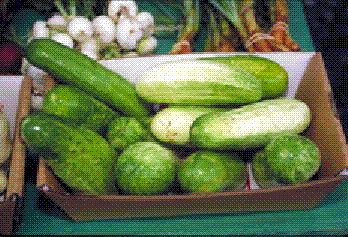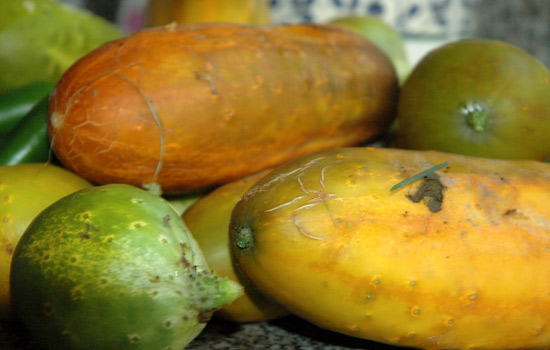
The cucumber (Cucumis sativus) is a widely cultivated plant in the gourd family Cucurbitaceae, which includes squash, and in the same genus as the muskmelon. The cucumber is also sometimes referred to as a cuke.
The fruit is commonly harvested while still green, though generally after the fruits outgrow their spines. They are eaten as a vegetable, either raw, cooked, or made into pickled cucumbers. Although less nutritious than most fruit, the fresh cucumber is still a source of vitamin C, vitamin K, and potassium, also providing dietary fiber, vitamin A, vitamin B6, thiamin, folate, pantothenic acid, magnesium, phosphorus, copper, and manganese. Cucumbers are used in the decorative food art, garde manger.


Cucumbers can be pickled for flavour and longer shelf life. As compared to eating cucumbers, pickling cucumbers tend to be shorter, thicker, less regularly-shaped, and have bumpy skin with tiny white- or black-dotted spines. They are never waxed. Color can vary from creamy yellow to pale or dark green. Pickling cucumbers are sometimes sold fresh as "Kirby" or "Liberty" cucumbers. The pickling process removes or degrades much of the nutrient content, especially that of vitamin C.
* English cucumbers can grow as long as 2 feet. They are nearly seedless and are sometimes marketed as "Burpless," as the seeds give some people gas.
* Japanese cucumbers are mild, slender, deep green, and have a bumpy, ridged skin. They can be used for slicing, salads, pickling, etc., and are available year-round.
* Mediterranian cucumbers are small, smooth-skinned and mild. Like the English cucumber, Mediterranian cucumbers are nearly seedless.
* Slicers grown commercially for the North American market are generally longer, smoother, more uniform in color, and have a tougher skin. Slicers in other countries are smaller and have a thinner, more delicate skin.
| < Prev | Next > |
|---|
















